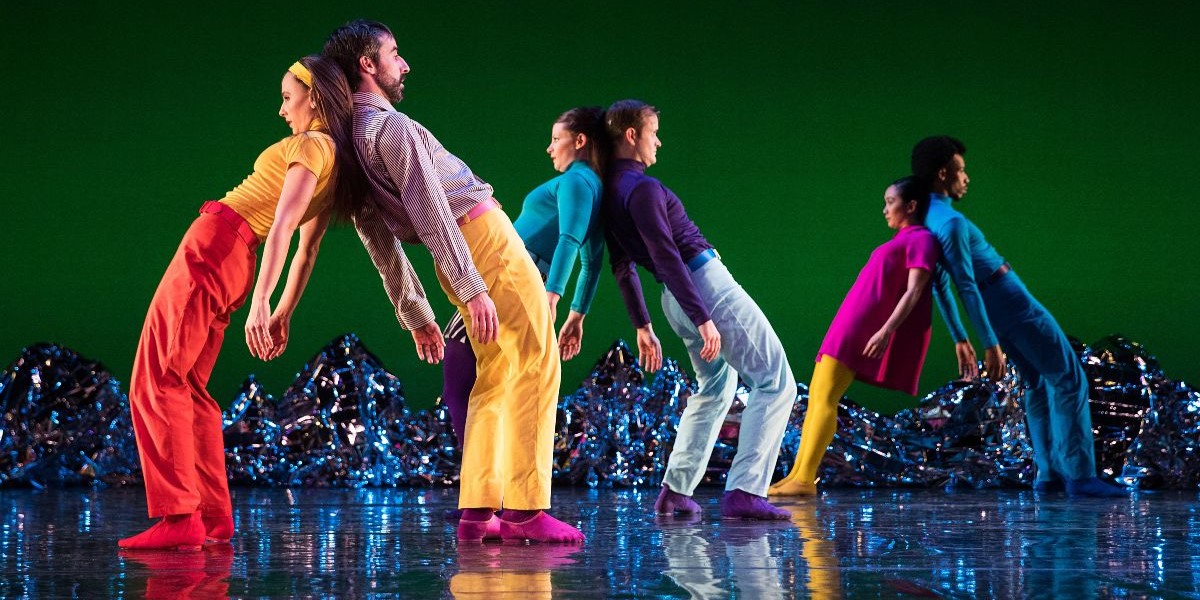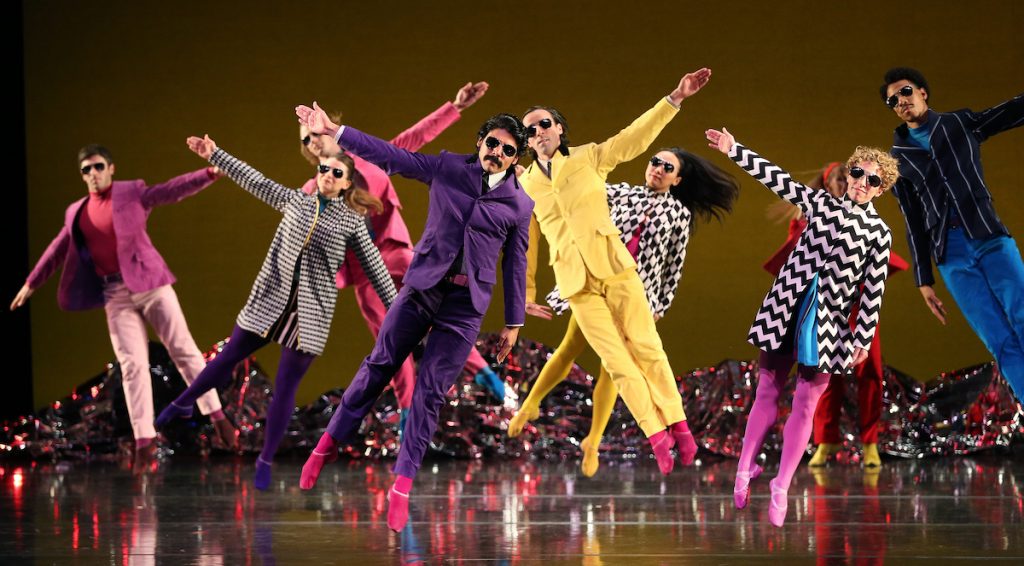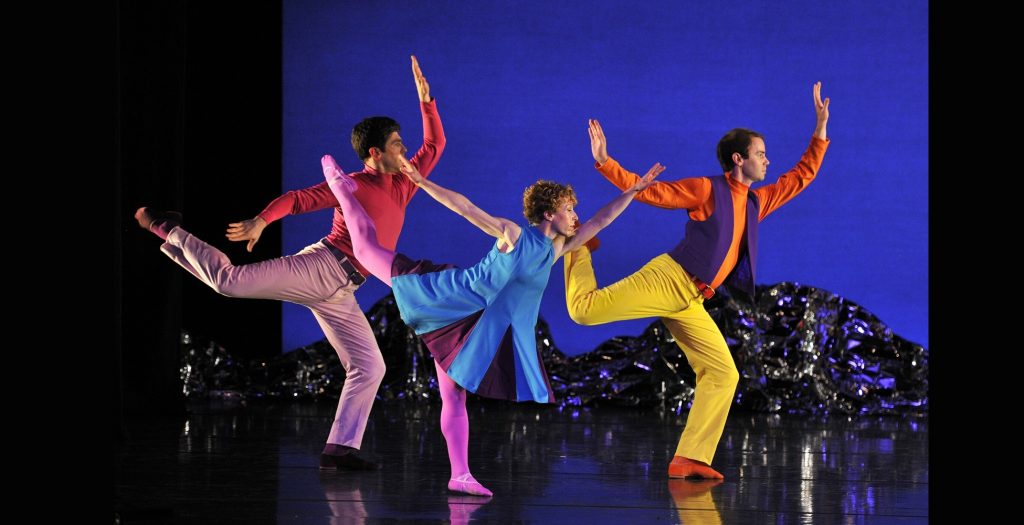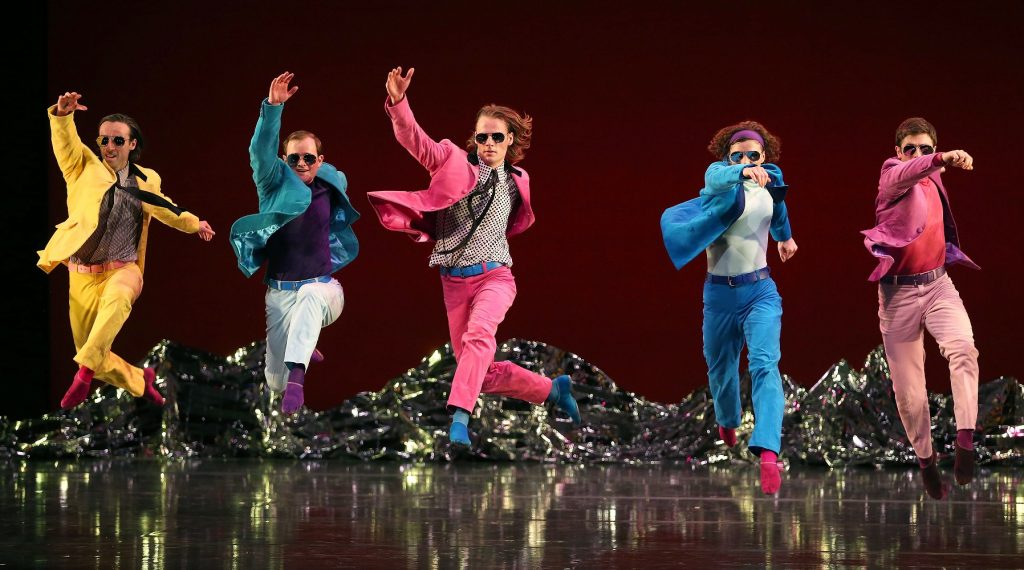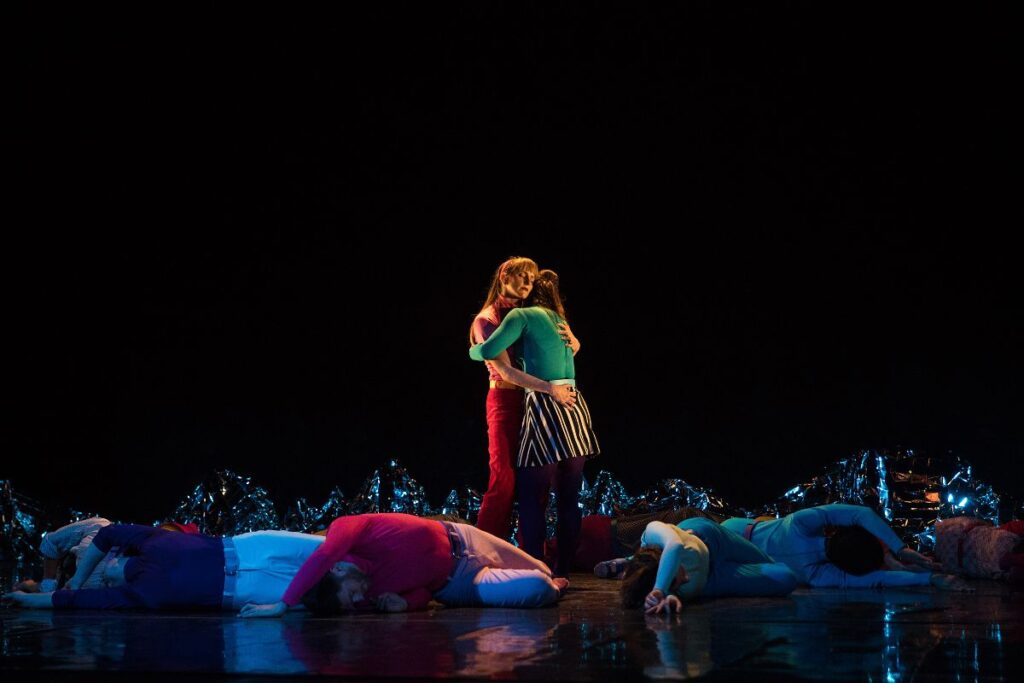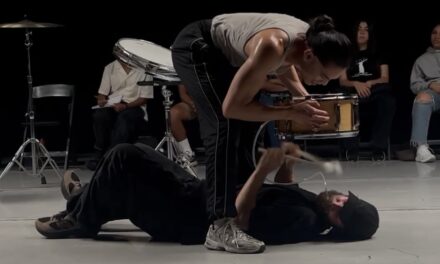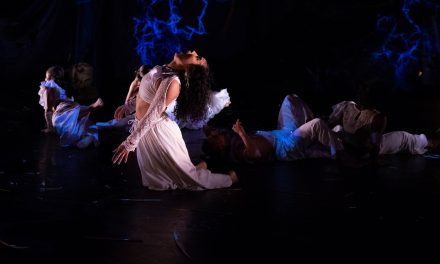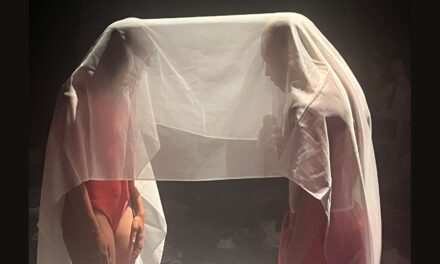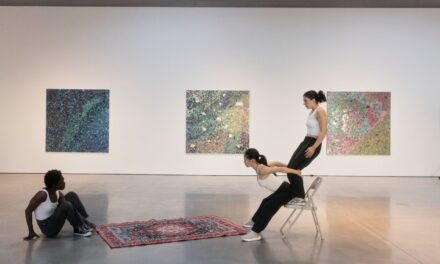As I settled into my seat at The Wallis, I immediately saw the musicians and found myself excitedly anticipating live music, a rarity these days. These phenomenal musicians did not disappoint! “Pepperland” is a beautiful marriage of movement and music created by renowned choreographer, Mark Morris as a tribute to the 50th anniversary of The Beatles’ “Sgt. Pepper’s Lonely Hearts Club Band”.
Merriam-Webster.com defines sunshine as “someone or something (such as a person, condition, or influence) that radiates warmth, cheer, or happiness.” When the lights came up, with the dancers standing center stage in brightly colored costumes (designed by Elizabeth Kurtzman), sunglasses, and Beetles music playing, it was as if the sun was shining. They were sunshine and they shined brighter and brighter and brighter as the evening went on. It was like watching a rainbow come to life. Socks, shoes, suits, shirts, ties, skirts, dresses of every color in the rainbow filled the stage. A voice introduced Marilyn Monroe, Fred Astaire, Albert Einstein, Shirley Temple, and others. Each introduction was accompanied by a dancer moving into a position, with a gesture, and facial expression reminiscent of the person. It was campy and fun, eliciting laughter from the audience. The dancers were clearly paying homage to these iconic figures.

Mark Morris Dance Group – Dallas McMurray, Mica Bernas, Domingo Estrada in “Pepperland” – Photo by Stephanie Berger.
Transitions throughout the evening were smooth, seamless, and effortless as the dancers moved through the different sections of this evening of Beatles music. The sheer musicality of the dancers, catching every musical nuance, as they moved from straight lines to diagonals, jumping, skipping, spinning, and twirling with joyous abandon. Lifts seem to come from nowhere with boys lifting girls, girls lifting girls, girls lifting boys, and boys lifting boys. Clearly these are men and women, but they have transformed before my eyes and gone back to a time we all loved.
The dancers move into a kick line that is sharp, sleek, creative, with some hip shaking from time to time. In dance lingo one might describe the hip movement as a “hip isolation,” but they were having so much fun that the clinical description just does not work. The ensemble moved in and out of the line unexpectedly creating a cacophony of the movement managing to get back in sync over and over. It was impossible to know when they would get back together or how long individuals, trios, and duets would break away or even what music they were dancing to. Somehow, Mr. Morris created a movement sequence that captured the individuality of each dancer and highlighted the ability of the ensemble to move in perfect unison. The dancers make this extremely complicated choreography look so easy, despite the speed and technical demands of so much of the movement.
One section is characterized by dancers using their arms like waves. In another section the dancers clap and slap their bodies in absolute synch with the music. It is as if they are another part of the musical accompaniment. Lifts happen and move across the stage as a voice can be heard talking about space. The dancers are continually covering the entire stage walking, running, jumping, lifting, and turning. They enter from everywhere, upstage, downstage, in diagonal lines, curved lines, and straight lines. Two motifs stand out. The first, a parallel walk in profile dragging one foot behind, reminiscent of an ancient Egyptian hieroglyph. This walk could be a line of two, three, or four people. The second was a lift in which the woman lifted appears to be flying, with her chest and head reaching for the sky, her arms stretched behind her like wings, and her hair flying in the wind created by the dancer running with her in his arms.
A review of the program reveals an eclectic group of well-trained and talented individuals from all over the world. The musicians and dancers are listed together, and bios include a multitude of advanced degrees from a variety of higher education institutions such as, Juilliard, De La Salle University, Case Western, University of Arizona, NYU Tisch, Cal Arts, SUNY Purchase, and North Carolina School of The Arts, just to name a few. Their experiences include, but are not limited to, Broadway, The Los Angeles Philharmonic, The Metropolitan Opera, Berlin Philharmonic, San Francisco Symphony, Jacobs Pillow, The Village Vanguard, and Radio City Music Hall. The dancers list experiences with well-respected companies including but not limited to Alvin Ailey American Dance Theatre, Lar Lubovitch Dance Company, Robert Battle’s Battleworks Dance Company, the Limón Dance Company, Ballet Philippines, Twyla Tharp Dance, Lucinda Child Dance Company and Hedwig Dances just to name a few. The musician bios reflect the same diversity in experience as the dancers. Most are multitalented, playing multiple instruments, composing, orchestrating, recording, and receiving recognition in The New York Times, the Downbeat Jazz Critic’s Poll, the Wall Street Journal and Hot House Jazz Magazine. Bobby McFerrin, Simon & Garfunkel, Wayne Shorter, Reneé Fleming, James Depriest, Lee Konitz, Jack DeJohnette, Ron Carter, Willie Nelson, and Antônio Carlos Jobim, are just a few of the musical luminaries that these talented musicians have performed with. Talent is the common denominator in this group of artists.
At this time in our country, when diversity, equity, and inclusion (DEI), are considered taboo, Mark Morris Dance Group is comprised of an eclectic group of artists. The dancers and musicians do not fit any particular body type, age group, sex, race, movement quality, dance or music style. Mr. Morris has assembled a group of phenomenal artists that bring so much to this evening-length work. At first glance the dancers look like “regular” people enjoying life. Everything looks effortless as they move across the stage. They create an illusion that allows the audience to step into the lives of people enjoying Beetles music. Everyone in the audience can relate to the people on the stage…representation matters.
Composer Ethan Iverson has created an original score that includes arrangements of “Sgt. Pepper’s Lonely Hearts Club Band,” “With a Little Help From My Friends,” “A Day in the Life,” “When I’m Sixty-Four,” “Within You Without You,” and “Penny Lane” with six original Pepper-inspired pieces created especially for Mark Morris Dance Group. The chamber music ensemble of voice, theremin, soprano sax, trombone, two keyboards, and percussion gives the Beatles music new twist with a layer of soul and rhythm that feels new but embraces the Beatles music we all know and love. Add the bright colorful costumes reminiscent of the Yellow Submarine Beetles album, metallic, bright, shiny scenic design by Johan Henckens, and lighting design by Nick Kolin it is as if the audience is transported to another time.
I found myself amid an audience that was primarily from that time of “Beetlemania.” From our reactions I think we were all fans of the music and the era. At the beginning of the piece, I was enjoying the male vocalist, and I was thinking, “that female voice is strange, kind of creepy, and familiar. What am I going to say about that?” As the piece progressed, I realized it wasn’t a female vocalist. I later learned it was a theremin, an instrument that I was not familiar with. It was an instrument that was featured in “The Long and Winding Road,” one of the last songs the Beatles did together (1970), and a favorite of mine. It is paired with the trombone at the beginning of a romantic number and was a perfect mood maker. As I read more about the theremin, an instrument invented around 1920 by Leon Theremin, a Russian Scientist, its relationship to this artistic venture by Mr. Morris became clear. The theremin is thought to be the first musical instrument with no “acoustic” ancestors and requiring no physical contact. Mr. Theremin brought the instrument to America in 1928, and audiences were shocked by the “otherworldly “ sounds created by a machine being played by an invisible force (The Impact of The Moog Theremin: A Brief History, 2024). Leon Theremin brought his invention to America in 1928, where he shocked audiences with the “sounds (and sights) of a machine played by an invisible force”. “Sgt. Pepper’s Lonely Hearts Club Band,” the inspiration for “Pepperland,” pushed the recording-studio technology of the late sixties and has been referred to as the inaugural “art rock” album. Using the theremin seems appropriate to extend Mark Morris’ exploration of the relationship between music and movement.
This is truly an exceptional ensemble of artists, musicians and dancers coming together to create a unique experience for the audience but also clearly enjoying every minute of movement and music. When the dancers just stand and sing, (and they sound remarkable) it is moving and touching, eliciting a nostalgic longing for a time that seems so far away. It creates a feeling like that of simply enjoying sunshine on a beautiful day. Then, there is the unison collapse to the stage that is a shock. There is no warning, no musical indicator, no special sound, it is just the end, after what seemed to be several false endings, it’s over, too soon, it’s over. After a second of silence, lights come up, he audience applauds, a standing ovation ensues and out walks Mark Morris with a large scarf tossed across his shoulder, a huge smile and wide, open arms. His bow felt like a warm hug filled with sunshine.
For more information about the Mark Morris Dance Group, please visit their website.
To learn more about The Wallis, please visit their website.
Written by Leah Bass-Baylis for LA Dance Chronicle.
Featured image: Mark Morris Dance Group in “Pepperland,” choreography by Mark Morris – Photo by Mat Hayward.

